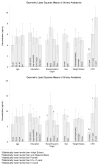Anabasine and Anatabine Exposure Attributable to Cigarette Smoking: National Health and Nutrition Examination Survey (NHANES) 2013-2014
- PMID: 35955098
- PMCID: PMC9368097
- DOI: 10.3390/ijerph19159744
Anabasine and Anatabine Exposure Attributable to Cigarette Smoking: National Health and Nutrition Examination Survey (NHANES) 2013-2014
Abstract
Anabasine and anatabine are minor alkaloids in tobacco products and are precursors for tobacco-specific nitrosamines (TSNAs). The levels of these two compounds have been used to differentiate tobacco product sources, monitor compliance with smoking cessation programs, and for biomonitoring in TSNA-related studies. The concentrations of urinary anabasine and anatabine were measured in a representative sample of U.S. adults who smoked cigarettes (N = 770) during the 2013−2014 National Health and Nutrition Examination Survey (NHANES) study cycle, which was the first cycle where urinary anabasine and anatabine data became available. Weighted geometric means (GM) and geometric least squares means (LSM) with 95% confidence intervals were calculated for urinary anabasine and anatabine categorized by tobacco-use status [cigarettes per day (CPD) and smoking frequency] and demographic characteristics. Smoking ≥20 CPD was associated with 3.6× higher anabasine GM and 4.8× higher anatabine GM compared with smoking <10 CPD. Compared with non-daily smoking, daily smoking was associated with higher GMs for urinary anabasine (1.41 ng/mL vs. 6.28 ng/mL) and anatabine (1.62 ng/mL vs. 9.24 ng/mL). Urinary anabasine and anatabine concentrations exceeded the 2 ng/mL cut point in 86% and 91% of urine samples from people who smoke (PWS) daily, respectively; in comparison, 100% of them had serum cotinine concentrations greater than the established 10 ng/mL cut point. We compared these minor tobacco alkaloid levels to those of serum cotinine to assess their suitability as indicators of recent tobacco use at established cut points and found that their optimal cut point values would be lower than the established values. This is the first time that anabasine and anatabine are reported for urine collected from a U.S. population-representative sample of NHANES study participants, providing a snapshot of exposure levels for adults who smoked during 2013−2014. The results of this study serve as an initial reference point for future analysis of NHANES cycles, where changes in the national level of urinary anabasine and anatabine can be monitored among people who smoke to show the effect of changes in tobacco policy.
Keywords: NHANES; anabasine; anatabine; cigarette smoking; cotinine; cut point; nicotine replacement therapy; tobacco biomarker.
Conflict of interest statement
The authors declare no conflict of interest.
Figures





References
Publication types
MeSH terms
Substances
LinkOut - more resources
Full Text Sources

